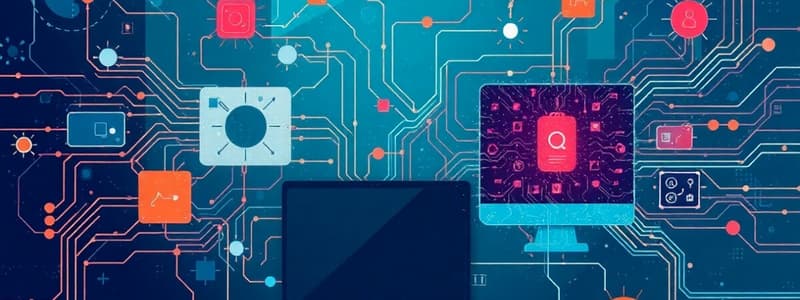Podcast
Questions and Answers
Which function of the operating system is MOST directly involved in allocating memory and CPU time to different applications?
Which function of the operating system is MOST directly involved in allocating memory and CPU time to different applications?
- Device Management
- Resource Management (correct)
- Data Management
- User Interface Management
Which characteristic is LEAST typical of a low-level programming language compared to a high-level language?
Which characteristic is LEAST typical of a low-level programming language compared to a high-level language?
- Results in faster direct execution
- Provides direct control over hardware
- Is machine-dependent
- Requires a compiler or interpreter for execution (correct)
Which of the following BEST describes the evolution of programming languages?
Which of the following BEST describes the evolution of programming languages?
- From problem-oriented to machine-oriented
- From machine-oriented to problem-oriented (correct)
- From complex to simple
- From high-level to low-level
How have advancements in touch screen technology MOST significantly impacted data acquisition?
How have advancements in touch screen technology MOST significantly impacted data acquisition?
Which storage type is BEST described as non-volatile?
Which storage type is BEST described as non-volatile?
Why is SDRAM developed?
Why is SDRAM developed?
What is the minimum number of bits required to store an 8-digit decimal number in BCD?
What is the minimum number of bits required to store an 8-digit decimal number in BCD?
What is the largest decimal value that can be represented using two bytes in binary format?
What is the largest decimal value that can be represented using two bytes in binary format?
Flashcards
Operating System
Operating System
Software that manages computer hardware and software resources and provides common services for computer programs.
Resource Manager (OS)
Resource Manager (OS)
An OS function that allocates and manages hardware resources (CPU, memory, storage).
Device Manager (OS)
Device Manager (OS)
An OS function that controls and manages hardware devices (printers, keyboards).
Data Manager (OS)
Data Manager (OS)
Signup and view all the flashcards
Low-Level Language
Low-Level Language
Signup and view all the flashcards
Modern Input Modalities
Modern Input Modalities
Signup and view all the flashcards
Read-Only Memory (ROM)
Read-Only Memory (ROM)
Signup and view all the flashcards
Cache Memory
Cache Memory
Signup and view all the flashcards
Study Notes
- The following are questions related to operating systems, human-computer interaction, computing devices, and data representation.
Operating Systems
- Definition of an operating system is required.
- Functions of an OS include:
- Resource management
- Device management
- Data management
- Examples of operating systems should be enumerated.
- Advantages and disadvantages of low-level languages need to be stated.
- A historical timeline of the evolution of programming languages must be sketched.
Human-Computer Interaction
- Impacts of input modalities on data acquisition and user experience need to be analyzed.
- The ways touchscreens and voice recognition shape human interaction with computers need discussion.
- Potential future trends in input devices are to be explored.
- An explanation of the evolutionary generation of computers must be provided.
- Output peripherals utilized in computing systems should be listed.
Computing Devices
- An overview of types of computing devices is needed.
- Information stored on a disc at manufacture that cannot be altered or deleted is read only.
- Hard disk drives are mass storage.
- Data storage after power loss is non-volatile.
- Data, programs, and processed information are temporarily stored in RAM during processing.
- Determining if a computer's RAM chip stores key system settings for boot-up is required (true or false).
- The reason for the above answer will need to be given.
- Over-clocking increases microprocessor speed relative to other components.
- An explanation of a memory structure to reduce delay in accessing RAM when over-clocking is needed.
Data Representation
- Calculators use BCD to store decimal values for display.
- The number of bits required for an 8-digit decimal calculator needs determining.
- Bits stored when 375 is entered into a calculator requires an explanation.
- Usefulness of octal and hexadecimal number systems must be discussed.
- Bytes needed to represent 846,569 in BCD should be calculated.
- Number of bytes in a 32-bit string is required.
- The largest decimal value representable in binary using two bytes must be stated.
- The repeated-division method of decimal-to-binary conversion should be explained via a flowchart.
Studying That Suits You
Use AI to generate personalized quizzes and flashcards to suit your learning preferences.




